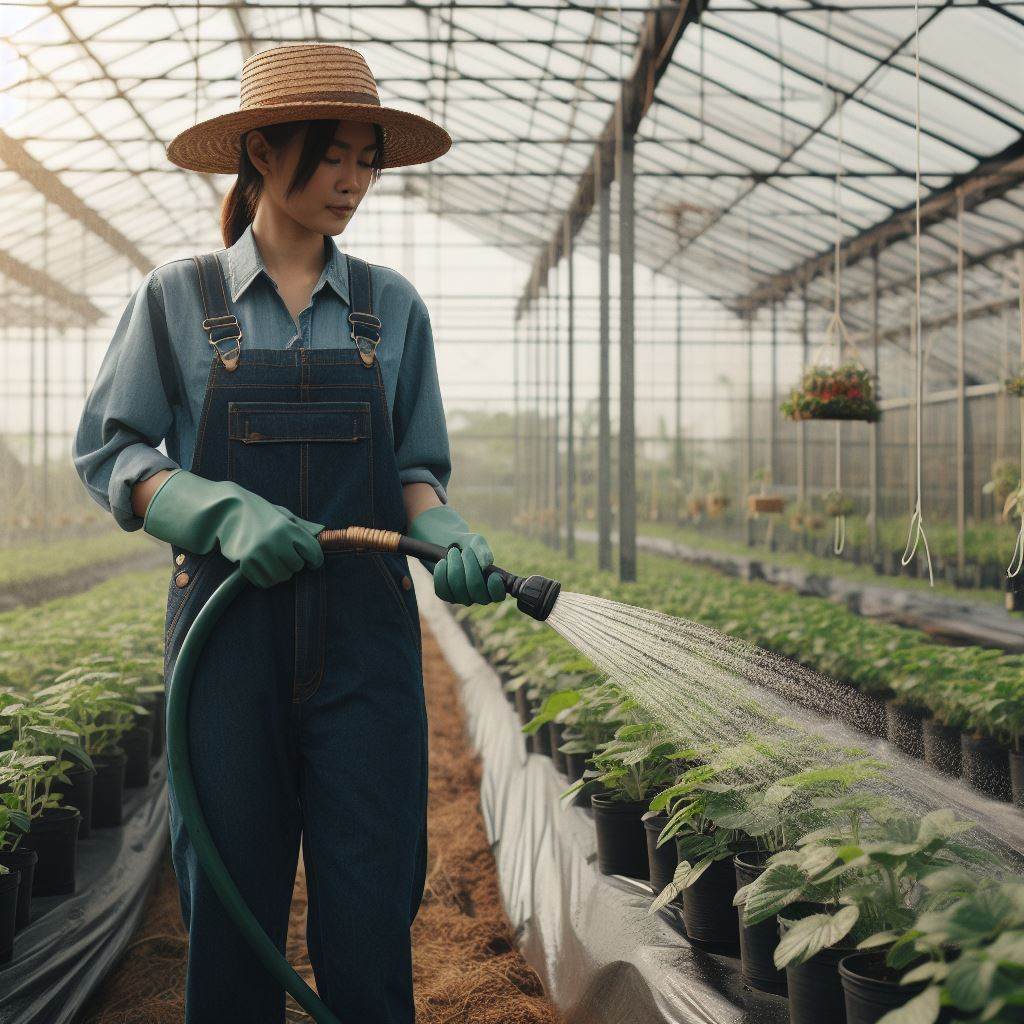Greenhouse Tech: Farming’s Answer to Climate Shift
Last Updated on March 2, 2024
Introduction
Let’s Explore Greenhouse Tech Farming Climate Shift
Climate change is a pressing issue that requires immediate attention, especially in the field of agriculture.
Greenhouse technology offers a promising solution to combat the adverse effects of climate shift.
Importance of addressing climate change in agriculture
Addressing climate change in agriculture is crucial as it directly impacts food production and security.
Rising global temperatures, erratic weather patterns, and increased pests and diseases threaten crop yields and livelihoods.
Introduction to greenhouse technology as a solution
Greenhouse technology provides an innovative approach to overcome climate change challenges in agriculture.
By creating controlled environments, it offers protection from extreme temperatures, pests, and diseases, enhancing crop productivity and quality.
With the ability to adjust temperature, humidity, and light, greenhouses create optimal growing conditions throughout the year.
This allows farmers to cultivate crops that would usually be seasonally restricted, improving food availability and diversity.
Moreover, greenhouse farming significantly reduces water consumption.
By utilizing irrigation techniques such as drip or hydroponics, water usage can be optimized, minimizing waste and alleviating the strain on water resources.
Additionally, greenhouse systems provide a shield against adverse weather conditions like strong winds, heavy rain, or hailstorms.
This reduces crop damage and ensures a steady and reliable harvest, even during extreme weather events.
Furthermore, the controlled environment of greenhouses enables efficient pest and disease management.
By implementing organic and biological control methods, the need for harmful chemical pesticides is reduced, promoting sustainable and environmentally friendly farming practices.
Therefore, greenhouse technology proves to be a promising solution to address the challenges posed by climate change in agriculture.
Its ability to create ideal growing conditions, reduce resource consumption, and minimize crop damage marks it as a viable and sustainable farming approach.
By embracing greenhouse technology, farmers can adapt to climate shifts and ensure a secure and resilient food system.
Understanding climate shifts and their impact
Climate shift, also known as climate change, refers to long-term changes in weather patterns globally
It has had a significant impact on farming practices and the agricultural sector as a whole.
Climate shift affects farming by altering the duration and intensity of seasons, leading to unpredictable weather patterns that affect crops and livestock.
Farmers have been forced to adapt to these changes in order to maintain their livelihoods.
Examples of climate shifts affecting agriculture globally
Examples of climate shifts affecting agriculture globally include prolonged droughts which reduce water supply for crops, increased flooding which damages crops and soil, and erratic temperature changes which affect plant growth.
Challenges faced by farmers due to climate change
Farmers confront climate change challenges, such as unpredictable weather patterns and the spread of pests and diseases.
These factors lead to reduced crop yields, impacting food security and availability.
To counter these challenges, farmers employ strategies like precision farming, crop rotation, and using resilient crop varieties.
Soil conservation techniques such as terrace farming and irrigation systems are also utilized.
Government and international organizations provide support through financial incentives and grants for sustainable farming practices.
Livestock farming faces challenges too, with extreme weather stressing animals and impacting productivity.
Rising temperatures alter grazing areas, necessitating alternative feeding methods and reduced animal populations.
Additionally, changes in pest infestations require constant monitoring and management.
Most importantly, climate change profoundly affects agriculture, but with climate-smart practices and support, farmers can mitigate its impact.
Collaboration among stakeholders is crucial for sustainable farming and food security.
Read: Biochar: Farming’s Climate Fix
Overview of greenhouse technology
Greenhouse technology is a game-changer in agriculture, providing farmers with a sustainable solution to climate change.
How does it work?
A greenhouse is a structure made of glass or transparent material that allows sunlight to enter.
This sunlight is then converted into heat, creating a warmer environment inside.
Different types of greenhouse structures
There are several types of greenhouse structures, each with its own advantages.
The most common ones include the traditional greenhouse, the hoop house, and the lean-to greenhouse.
Traditional greenhouses have a pitched roof, which allows for better ventilation and prevents the structure from overheating.
They are typically used for commercial farming and have a more robust construction.
Hoop houses, on the other hand, have a rounded roof and are made of metal or PVC pipes.
They are cheaper and easier to assemble, making them ideal for small-scale farmers or hobbyists.
Lean-to greenhouses are attached to an existing building, usually a house or a shed.
They are a cost-effective option and provide easy access to utilities like electricity and water.
Benefits of greenhouse farming
Greenhouse farming offers year-round cultivation regardless of external climate, promoting winter crop growth.
It shields crops from pests and diseases, reducing chemical pesticide usage and ensuring healthier produce.
The controlled environment allows precise irrigation, conserving water and optimizing crop growth.
Greenhouse Tech Farming Climate Shift can regulate temperature and humidity with technologies like automatic ventilation and renewable energy sources.
Hydroponic or aeroponic systems enable cultivation without soil, overcoming fertility issues and maximizing land utilization.
Exotic or out-of-season crops thrive in greenhouses, creating ideal growing conditions and expanding agricultural possibilities.
Extended growing seasons and increased yields boost profitability, reducing reliance on external suppliers and enhancing economic stability.
Greenhouse technology revolutionizes agriculture, providing a sustainable solution to climate change and ensuring food security.
In essence, greenhouse farming addresses climate challenges by enabling year-round cultivation, pest protection, water conservation, and energy efficiency.
Read: Urban Farms: Answer to Climate?
The role of greenhouse technology in mitigating climate change
Greenhouse technology plays a crucial role in mitigating climate change and its effects on farming.
By reducing greenhouse gas emissions and improving resource utilization, it offers a sustainable solution for food production while protecting crops from extreme weather events.
Reduction of greenhouse gas emissions
Greenhouse technology helps reduce the emission of greenhouse gases by enabling controlled cultivation conditions.
By utilizing energy-efficient systems, such as solar panels, it minimizes reliance on fossil fuels.
This significantly lowers carbon dioxide levels, mitigating climate change impacts.
Improved efficiency in resource utilization
Greenhouse Tech Farming Climate Shift optimizes resource utilization through various techniques.
It involves precise water management systems that reduce wastage and ensure crops receive adequate moisture.
Additionally, advanced fertilization methods optimize nutrient uptake, minimizing pollution and reducing the need for excessive chemical use.
Protection from extreme weather events
Extreme weather events, such as storms, droughts, and heatwaves, pose significant risks to traditional farming.
Greenhouse technology provides a protective shield against these threats.
The controlled environment shields crops from unpredictable weather, ensuring their safety and enhancing resilience against climate shifts.
Moreover, the use of advanced technologies, such as automated climate control systems and weather monitoring devices, allows farmers to anticipate and respond to adverse weather conditions promptly.
Extended growing seasons and increased yield
Greenhouse Tech Farming Climate Shift extends the growing season by creating optimal conditions throughout the year.
This means farmers can cultivate crops even during winter or in regions with unfavorable climates.
By maintaining constant temperatures, controlling humidity levels, and providing adequate lighting, greenhouses enable continuous growth and higher yields.
This ensures a stable food supply while reducing the reliance on imports and transportation, thus minimizing carbon footprints.
Conservation of water resources
Water scarcity is a growing concern globally, making efficient water management crucial for sustainable farming.
Greenhouse technology enables precise irrigation systems that minimize water wastage.
Techniques like drip irrigation and hydroponics facilitate the targeted delivery of water directly to the roots, reducing evaporation and runoff.
Additionally, condensation collection systems within greenhouses help capture and reuse water, further conserving this valuable resource.
Minimization of pesticide use and pollution
Traditional farming often requires significant pesticide application to combat pests and diseases.
However, excessive pesticide use has detrimental effects on ecosystems and human health.
Greenhouse Tech Farming Climate Shift mitigates this issue by providing a controlled environment that limits pest infestations.
The barrier provided by greenhouses reduces the need for pesticides, ensuring healthier produce and minimizing chemical pollution.
Integrated pest management techniques, such as biological control, can be effectively employed within greenhouses to maintain crop health sustainably.
In fact, greenhouse technology revolutionizes agricultural practices, mitigating climate change’s adverse impacts on farming.
Through the reduction of greenhouse gas emissions, efficient resource utilization, protection from extreme weather events, and various other benefits, it enables sustainable and resilient food production.
Embracing this technology empowers farmers to adapt to changing climates while reducing the environmental footprint of agriculture.
Read: Storms & Soil Erosion: Safeguarding US Farmlands

Greenhouse Technology’s Impact on Crop Quality and Productivity
Greenhouse technology has revolutionized farming by offering increased control over environmental conditions.
The use of greenhouses allows farmers to manipulate temperature, humidity, and light to optimize plant growth.
This control leads to improved crop quality as the plants are provided with ideal growing conditions.
Greenhouses also extend the growing seasons, allowing farmers to cultivate crops throughout the year.
By providing a stable and controlled environment, greenhouses protect crops from extreme weather conditions and pests.
This leads to higher crop yields and a more reliable food supply for communities.
Furthermore, greenhouse technology reduces the need for chemical pesticides as environmental conditions are closely monitored.
Instead of relying on harmful chemicals, farmers can implement natural pest control methods such as biological control.
This not only benefits the environment but also ensures safer and healthier produce for consumers.
Increased Control over Environmental Conditions
- Greenhouses offer a controlled environment where temperature, humidity, and light can be adjusted.
- Farmers can optimize these conditions to suit the specific needs of different crops.
- Controlling temperature prevents extreme heat or cold from harming plants.
- Optimal humidity levels promote healthy growth and reduce the risk of diseases.
- Adjustable light exposure ensures that crops receive the right amount of sunlight for photosynthesis.
Extended Growing Seasons and Crop Yields
- With greenhouses, farmers can cultivate crops year-round regardless of external climate.
- By extending growing seasons, farmers can harvest multiple crop cycles within a year.
- This significantly increases overall crop yields and profitability.
- Greenhouses also provide protection from extreme weather conditions, such as storms or frost.
- By safeguarding crops, farmers can ensure a consistent and reliable supply of produce.
Reduction in Chemical Pesticide Usage
- Greenhouses create a barrier that prevents pests and diseases from infesting crops.
- As a result, farmers can reduce their reliance on chemical pesticides.
- By closely monitoring environmental conditions, farmers can identify and control pests before they become a major problem.
- Instead, natural pest control methods like introducing predator insects can be employed.
- This reduces the harmful impact of traditional pesticides on the environment and human health.
Basically, greenhouse technology has a profound impact on crop quality and productivity.
Through increased control over environmental conditions, farmers can optimize plant growth and improve crop quality.
Extended growing seasons and reduced pesticide usage further contribute to higher crop yields and healthier produce.
By embracing greenhouse technology, farming can become a sustainable and climate-friendly solution to feeding our growing population.
Read: Climate Resilient Agriculture: A Guide
Economic and financial implications
Implementing greenhouse technology requires careful consideration of costs and potential profitability.
Costs for implementing greenhouse technology can vary depending on the size and level of automation.
However, the initial investment in greenhouse technology can be substantial, including construction, equipment, and utilities.
Despite the initial costs, greenhouse technology offers the potential for increased profitability in farming operations.
Greenhouse-grown produce is often of higher quality and can command premium prices in the market.
Consumers are increasingly demanding locally grown, pesticide-free, and fresh produce, creating a market opportunity.
With controlled climate and optimized growing conditions, greenhouse-grown produce has a longer shelf life and reduced waste.
Efficiency in water and nutrient usage further contributes to cost savings and profitability in greenhouse farming.
Additionally, greenhouse technology allows farmers to extend their growing season, increasing the potential for multiple harvests.
This extended growing season enables farmers to supply fresh produce even during off-seasons when prices are typically higher.
Economic opportunities for rural communities
Rural communities can benefit economically through greenhouse farming as it provides employment opportunities.
Local residents can be trained and employed in greenhouse operations, supporting local economic development.
Greenhouse farming also reduces the dependence on importing produce, which stimulates the local economy.
Rural communities have the potential to become self-sufficient in meeting their food demand through greenhouse technology.
The revenue generated from greenhouse farming can be reinvested in other local businesses, creating a multiplier effect.
Furthermore, greenhouse technology can attract agro-tourism, where visitors can observe and learn about innovative farming practices.
This can generate additional revenue for rural communities through tourism-related services and products.
Essentially, while implementing greenhouse technology may have initial cost considerations, the potential for increased profitability and market demand outweighs the investment.
Rural communities can benefit economically and become self-sufficient while promoting sustainable farming practices.
Discover More: Solar Tech in Modern Agriculture
Case studies and success stories
In the Netherlands, the company Koppert Cress uses a high-tech greenhouse to grow microgreens and edible flowers.
With the controlled environment, they achieve year-round production and reduce their water and pesticide usage.
Koppert Cress’s approach has allowed them to meet the increasing demand for fresh, sustainable produce.
Similarly, in Japan, Mirai Co. operates a vertical farm inside a high-rise building using state-of-the-art technology.
By optimizing the use of space and resources, Mirai Co. can grow various vegetables efficiently.
Their farm produces more than 10,000 heads of lettuce per day, contributing to food security in urban areas.
With shorter supply chains, greenhouse farms like these reduce transportation emissions and food waste.
Furthermore, the Fresh Box Farms in Massachusetts demonstrates the potential for urban farming with their vertical greenhouses.
They repurpose old shipping containers to create self-contained farms that require minimal land and water.
Fresh Box Farms can harvest crops year-round, providing fresh produce to local communities even in cold climates.
Through hydroponics and advanced LED lighting, they achieve resource-efficient growing methods and eliminate herbicide use.
These successful examples of greenhouse farming highlight the immense possibilities and positive outcomes available.
Outcomes and benefits experienced by farmers
- Enhanced crop quality: Greenhouses allow farmers to closely control the growing conditions, resulting in higher-quality crops.
- Consistent yields: By eliminating the dependence on seasonal changes, greenhouse farming ensures a more reliable and consistent supply.
- Increased productivity: With optimized growing conditions, farmers can achieve higher yields per square meter compared to traditional farming.
- Water efficiency: Greenhouse technologies enable efficient water management through techniques like drip irrigation and recirculation systems.
- Reduced pesticide use: By creating a controlled environment, greenhouse farming reduces the need for chemical pesticides.
- Extended growing seasons: Through the use of supplemental lighting and climate control, farmers can extend their growing seasons.
- Protection against climate change: Greenhouses serve as a shield against extreme weather events, providing a stable environment for crops.
- Local food production: Urban and vertical farming in greenhouses allows for fresh produce to be grown close to consumers, reducing transportation.
- Job creation: The establishment of greenhouse farms creates job opportunities in both rural and urban areas.
- Innovation and technology adoption: Greenhouse farming encourages the adoption of cutting-edge technologies and sustainability practices.
All these outcomes and benefits collectively contribute to a more resilient and sustainable agricultural system.
Greenhouse Tech Farming Climate Shift offers an effective solution to combat the challenges posed by climate shift and allows for continued food production in a changing world.
You Might Also Like: Regenerative Agri: Earth’s Lifeline
Challenges and Limitations of Greenhouse Technology
Greenhouse technology has gained popularity in recent years as a sustainable farming solution.
However, it is not without its challenges and limitations.
Let us explore some of them:
High Initial Investment and Ongoing Operational Costs
One of the primary challenges faced by farmers when adopting greenhouse technology is the high initial investment required.
Building a greenhouse involves significant expenses, including the cost of materials, construction, and installation of equipment such as heating, ventilation, and irrigation systems.
Moreover, there are ongoing operational costs associated with maintaining a greenhouse.
These costs include electricity, water, heating, and cooling expenses.
The farmers must consider these financial burdens before deciding to implement greenhouse technology.
Energy Consumption and Potential Environmental Concerns
Greenhouse technology relies heavily on energy consumption to regulate temperature, humidity, and lighting conditions.
Heating and cooling systems, as well as artificial lighting, require a substantial amount of electricity.
This energy demand contributes to greenhouse gas emissions and increases the farmer’s carbon footprint.
While efforts are being made to develop energy-efficient greenhouse systems, the issue of energy consumption remains a concern.
The agriculture industry must seek sustainable energy solutions to minimize greenhouse gas emissions and reduce dependence on non-renewable energy sources.
Limited Scalability and Applicability in Certain Regions
Another limitation of greenhouse technology is its limited scalability and applicability in certain regions.
Greenhouses are typically constructed using specific designs and materials tailored to local climatic conditions, such as temperature, humidity levels, and sunlight availability.
This limitation restricts the widespread implementation of greenhouse technology in regions with extreme climates or unsuitable environmental conditions.
For example, areas with high wind speeds, frequent storms, or where sunlight is limited may face challenges in maintaining the ideal growing conditions inside the greenhouse.
Furthermore, the technology may not be economically viable in regions with a small farming sector or limited market demand for greenhouse-grown produce.
In such cases, farmers may find it challenging to recoup their initial investment and sustain profitable operations.
While greenhouse technology offers numerous benefits, it also poses several challenges and limitations.
The high initial investment and ongoing operational costs can deter farmers from adopting this technology.
Additionally, energy consumption and potential environmental concerns need to be addressed for a more sustainable approach.
Moreover, limited scalability and applicability in certain regions pose obstacles to widescale implementation.
It is crucial for farmers and technology developers to collaborate and find innovative solutions to overcome these challenges.
By doing so, greenhouse technology can continue to play a crucial role in sustainable farming, contributing to food security and minimizing the impact of climate change.
Conclusion
Greenhouse technology offers numerous benefits in mitigating climate change.
Greenhouses provide a controlled environment that reduces the reliance on natural resources and minimizes carbon emissions.
By growing crops in a greenhouse, farmers can ensure year-round production, increased crop yield, and protection against extreme weather conditions.
It is crucial for farmers to consider adopting greenhouse tech farming practices in order to adapt to the changing climate and secure food production.
Greenhouses offer sustainable solutions that can help farmers become more resilient to the challenges posed by climate shift.
Moreover, greenhouse farming can also contribute to local economies and food security.
However, in order to fully harness the potential of greenhouse tech farming, further research and innovation are necessary.
It is essential to develop more efficient and cost-effective techniques that address the limitations of current greenhouse systems.
Additionally, exploring renewable energy sources and novel materials can enhance the sustainability of greenhouse tech farming climate shift.
Greenhouse technology presents a promising solution for agriculture in the face of climate change.
Farmers should embrace this technology, while researchers and innovators continue to push the boundaries of greenhouse farming for a greener and more sustainable future.


